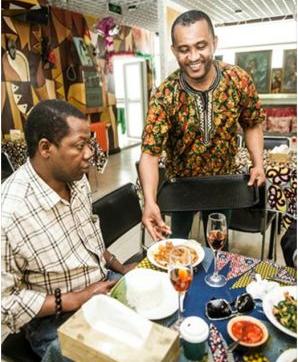A bite of Africa
Beijing gets a taste of the Saharan continent’s best dishes from Angola to Zimbabwe
Turay Lamin serves a diner at his restaurant Turay’s Africa House in Sanlitun, Chaoyang district. The Sierra Leonean opened his restaurant, which specializes in sub-Saharan fare and serves as a hub for Beijing’s African community, 15 years ago. Photo: Li Hao/GT
When Badr Benjelloun first came to China for business in 2004, he only planned to stay two weeks. As the IT manager’s work contract gradually extended, so too did his fascination in the country. A decade later, the 36-year-old is still in China and at the helm of popular Moroccan restaurant Cuju located in Xiguan Hutong, Dongcheng district.
“I don’t get homesick because I make dishes from my hometown,” said Benjelloun, who is originally from Morocco’s largest city Casablanca. “[China] is a weird country because everywhere is so different. The people and dialects are different, and the food is even more different from place to place.”
Benjelloun’s observation is based on his extensive travels in China, which have taken him to Hebei, Heilongjiang, Jiangsu and Zhejiang provinces, and the Ningxia Hui and Xinjiang Uyghur autonomous regions. His home since 2006 has been Beijing, which despite its reputation as a melting pot for international cuisines is still underrepresented by African restaurants.
But all that could be about to change amid deepening ties and growing people-to-people exchanges between China and Africa. However, the real way to people’s hearts could lie through their stomachs.
Flavors of Morocco
Africa boasts a diverse culinary landscape that includes a broad spectrum of foods and flavors.
“You can view Africa as three parts: northern Africa, central Africa and southern Africa,” explained Benjelloun, who describes northern African cuisine as being heavily influenced by Mediterranean and Arab cultures. By contrast, central African cuisine is based predominantly on vegetables, grains, sorghum and corn, while southern Africa is regarded for its “rainbow cuisine” featuring European, Indian and indigenous influences.
Moroccan dishes are mostly cooked and served in a clay pot known as a tagine. Heated over coals, the tagine has a flat bottom and a conical top. Moroccan cooking relies little on water, with the natural juices of vegetables and meats used as a substitute.
“All Moroccan food is slow-cooked. Every main dish takes three to four hours to cook. Moroccan food might be slow to cook, but the result is amazing,” said Benjelloun.
As an agrarian society, Moroccan farmers traditionally prepare a slow-cooked meal that is ready for lunch before leaving home at dawn to work.
Beijing’s Moroccan community is small, numbering about 100 based on Benjelloun’s estimate. As a result, much of the food at the core of its cuisine is imported rather than sourced locally.
“Shanghai and Guangzhou have larger trading areas and bigger African populations, so they have more African ingredients,” said Benjelloun, who sources rosewater and couscous from both cities.
Benjelloun also stocks up on supplies, including the shrub wormwood used in tea, cooking and cocktails, each time he returns to Morocco.
Although he likes to experiment by using Chinese ingredients in Moroccan cooking to create fusion cuisine, he prefers to stay faithful to authentic tastes from home.
“Take the merguez,” said Benjelloun, referring to a spicy mutton- or beef-based sausage eaten between bread. “Moroccan bread is amazing but you can’t buy it in Beijing, so we compromise. What we use now is more like a mo (steamed bun), but it is very similar to the Moroccan bread batbout.”
Stewing with sub-Saharans
Originally from Harare, Zimbabwe, Tawanda Michael Mahere has been studying in China for five years. He often attends the workshops held by the Sino-Africa Center of Excellence Foundation at Turay’s, which teach the African students how to advance their careers with their education experience in China. During that time he has satisfied his urge for tastes of home at Sanlitun restaurant Turay’s Africa House, where he has dined four times in the last two months.
“In our country, there are a lot of avocado trees. We simply raise our hands and can pick one to eat,” said Mahere. “The avocado salad here [at Turay’s Africa House] always reminds me of my hometown.”
Walking into the restaurant, the first feast served to customers is a visual one: paintings, carvings and handicrafts depicting Africa’s grasslands, wildlife and traditional costumes adorn the walls.
The restaurant’s owner is Sierra Leonean Turay Lamin, who launched the business 15 years ago. Specializing in Pan-African and Caribbean-style cuisines, the restaurant has moved several times since it opened before settling at its current location near the Yashow Market.
The restaurant might have a distinct African feel, but diners are often surprised to discover a Chinese face in the kitchen.
Head chef Liu Guanwei said the restaurant has served as the local African community’s social center, with more than 70 percent of diners on average hailing from sub-Saharan countries including Niger, Sierra Leone, Zimbabwe, Cote d’Ivoire and Cameroon. The menu is built around dishes from eastern and central Africa. One of the most popular is okra stew, which features onion, dried shrimp, African red oil and beef.
Most mains are typically accompanied by a white or yellow semo, a grain-flour staple made of corn popular across Africa. About one-third of ingredients at the restaurant are imported, including yams native to Africa that are much bigger than those grown in China.
“Stewing and boiling are the main cooking methods for eastern and central African cuisines. Most dishes look primitive,” said Liu.
Liu and Lamin have been close friends for over a decade. Liu initially mastered French and Italian cuisines in the hope it would be more profitable and promising for his career, but he decided to help his African friends to run the restaurant. Liu learned African cookery from Lamin’s wife, and eventually became one of the few chefs in Beijing to specialize in the cuisine. Now, Lamin attests his cooking is as authentic as chefs in Africa.

Zaalook, a cooked salad popular in Morocco made with eggplant, tomatoes, garlic, olive oil and spices. Photo: Courtesy of Badr Benjelloun
Somewhere over the rainbow
Unlike the simple, centuries-old cuisines found across most of the continent, South African food is more delicate and fuses many styles.
“South Africa is called the ‘rainbow nation’ for a reason. We are the biggest country of mixed cultures, colors, backgrounds, histories and languages in the world. We have 11 official languages,” said Andrew White, wine specialist at Pinotage, a South African restaurant and wine bar in Sanlitun. The establishment’s decor is oozes European influences with warm golden light and large wooden wine shelves in stark contrast to the tribal appeal of Turay’s Africa House.
South African cuisine includes influences from Malaysia due to the historic slave trade, Europe due to colonial settlers and India due to those who worked as indentured laborers on sugar plantations under British rule. Cookery practices of indigenous peoples, such as the Sotho- and Nguni-speaking ethnic groups, also form an integral part of “rainbow cuisine.”
Like Turay’s Africa House, Pinotage’s head chef is Chinese. When he began learning about South African cuisine, Li Tingfang was fascinated by its abundant use of meat, and sweet and sour flavors. One of the restaurant’s specialties is a menu item one would be hard-pressed to find anywhere else in Beijing: ostrich burgers.
“Ostriches are abundant and indigenous in South Africa, and we raise them for the feather industry,” explained White. “It is very healthy as a meat because it contains little fat. The meat is very lean, rich in red-meat flavor and has a taste between venison and beef.”
The sour and sweet flavors of South African cuisine are perhaps best captured in biltong, a salty dried meat soaked in a special sauce containing three different kinds of vinegar.
“We import black vinegar from South Africa, and it is used in a lot of dishes including our ostrich burger,” said Li. “Our roast lamb is glazed in tomato juice and red wine, which makes it taste different from other roast meat.”
The name of the restaurant comes from a red grape variety from South Africa, which is a cross between pinot noir and hermitage first cultivated in the 1950s.
Meal fit for a king
Beijing used to be home to more African restaurants, but some closed due to their limited appeal with locals in the city’s cutthroat hospitality industry. Among these were Pili Pili, which used to invite African cooks to prepare barbecues with crocodile and ostrich meat, and Ras Ethiopian, which was renowned for its tribal dance performances.
Benjelloun knows his business can’t survive on Beijing’s tiny Moroccan community alone, but he doesn’t have plans to mimic Chinese restaurants’ menus to cater to locals.
“I will not compromise by adopting Chinese flavors,” he said. “There used to be two more Moroccan restaurants in Beijing, but they closed for a reason.”
Cuju plans to unveil its new menu next week, which Benjelloun hopes will let more people better understand and appreciate Moroccan food.
King Mohammed VI of Morocco is slated to visit Beijing next month. As the only Moroccan restaurant in town, Cuju could etch its place on the monarch’s itinerary. However, Benjelloun believes the king won’t want to eat food from home.
“If he comes, I will serve him Ningxia minced-meat noodles, because he has eaten enough Moroccan food in Morocco. In China, I want to serve him my favorite Chinese dish,” he laughed.
By Li Lin Source:Global Times, China
Stay with Sierra Express Media, for your trusted place in news!
© 2014, https:. All rights reserved.









